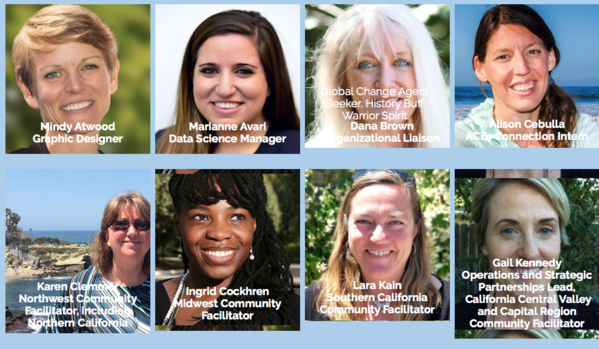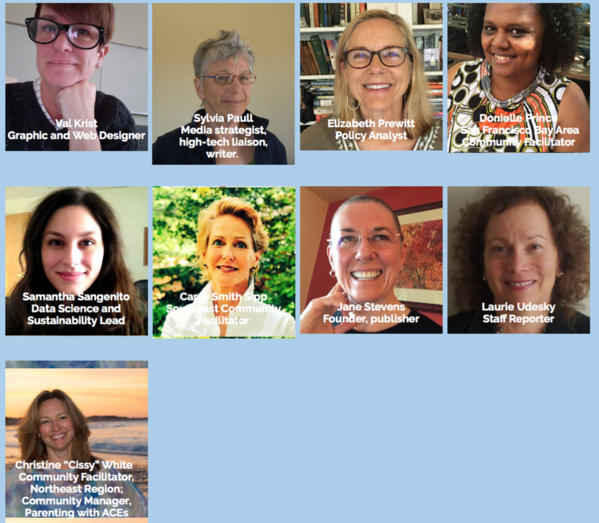One person asked me recently if ACEs Connection does anything besides distribute news about ACEs science and trauma-informed/resilience-building practices based on ACEs science. Another was surprised that it’s a social network with more than 35,000 members (and growing). And I’d guess that most of those members have no idea that we support more than 300 local ACEs initiatives (and growing).
ACEs Connection reminds me of the elephant in the parable that originated in India about the blind men and that wonderful beast. Each blind man touches a different part of the elephant and attempts to describe it based on that one part. One says it’s a thick snake (trunk), another a wall (side), another a rope (tail).
So, it’s high time that I do my due diligence as a journalist and provide some information for those who don’t know about all the things we do. A consumer guide for ACEs Connection, if you will.
Before exploring all of our very cool parts, our new “brochure” site, ACEsConnectionInfo.com, can help with an introduction. It gives you a real quick overview of how we’re supporting communities to accelerate the use of ACEs science to solve humans’ most intractable problems. We do this in three ways:
- We provide a social network for the ACEs movement through ACEsConnection.com.
- We support more than 300 ACEs initiatives in the U.S. and the world.
- We act as the information resource for the ACEs movement.
So, here are all the parts of our amazing elephant:
Information hub and social network for the ACEs movement:
— Our social network, ACEsConnection.com, summarizes ACEs-science related news, reports and research in daily blog posts. We also send out a daily digest and weekly roundup, which includes ACEsConnection.com members’ remarkable and compelling blogs. We also have a news site, ACEsTooHigh.com, for the general public.
— a robust Resources Center provides links to many ACE and resilience surveys, ACEs science presentations that are free to use, parent handouts, resources in Spanish, research, reports, videos, webinars, etc.!
— A Calendar lists upcoming events and webinars around the nation and the world.
— Mapping the Movement, is a layered, searchable, interactive map with three layers (so far): state legislation and resolutions, states that have done BRFSS surveys, and ACEs initiatives across the globe.
— Speakers & trainers bureau, maps presenters and provides details about their presentations.
— Ask the Community is where ACEsConnection.com’s 35,000+ members ask and provide answers to such questions as…Who’s doing trauma-informed probation? Is anyone working with trauma-informed recreation departments? Anyone have data for the Handle With Care program? Individual members can also message each other privately.
— Videos and archives
— Links to all the webinars we do as well as those we do in partnership with other organizations.
Support for ACEs initiatives:
— ACEs Connection provides sites on ACEsConnection.com for the more than 300 (and growing) ACEs initiatives. Each functions like a mini-ACEs Connection. Each site has its own banner, section for blogs, Ask the Community, videos, archives for meeting minutes of steering committee and other committees such as healthcare and education, and a calendar.
Many initiatives use tools such as the Presentations Tracker, where they can track the ACEs presentations they do across sectors and the geographic community to assess the impact of the ACEs initiative and plan next steps. (If your community doesn’t have a Presentations Tracker and wants one, contact the ACEs Connection Community Facilitator for your area. You can find her hereor in the Growing Resilient Communities section in the right column on the ACEsConnection.com home page.)
In the Fall, we will add another suite of unique tools that will help communities track outcome data. For the California county sites, we partnered with Kids Data to provide local ACEs and resilience data about children and maternal mental health.
— Interest-based communities such as Parenting with ACEs, ACEs in Education and ACEs in Pediatrics.
— A robust search function to find information and people.
— Private messaging.
— Our guide, Growing Resilient Communities, for neighborhoods, cities, counties, regions and states that want to start and grow ACEs initiatives. If you’re in a community that doesn’t have an ACEs initiative and you want to start one, contact the ACEs Connection community facilitator in your region. You can find her here or in the Growing Resilient Communities section in the right column on the home page. She can also tell you if there’s an initiative that’s launching soon.
Who facilitates all this?
— Six ACEs Connection community facilitators assist local ACEs initiatives across the U.S. and the world. They make hundreds of connections daily for members. They help set up local ACEs initiatives, set up ACEs initiative communities on ACEs Connection, and help local ACEs initiatives grow. They connect people who have information with those who need it, attend ACEs initiative meetings, and summits, where they often do presentations about ACEs science and how communities are integrating ACEs science into their lives and work. They also post blogs on ACEsConnection.com and host or do webinars.
And for the rest of our functions, a network manager oversees the ACEsConnection.com social network. A data science manager helps develop new state-of-the art tools for communities. A policy analyst keeps track of and writes about legislation and policy at the national and state levels. One reporter covers developments in the San Francisco Bay Area Community and in the national pediatric community. Three in the executive team develop new state-of-the-art programs and guidance for ACEs communities, as well as the overall strategy for ACEs Connection, and write articles. We also have two amazing interns.
To see all of our great team, and find out more about them, go to the Who We Are section in our new “brochure” site, which you can always find through the About tab in the navigation bar at the top of the ACEsConnection.com home page.
And if you have questions and/or suggestions, all of us on this amazing team are all ears! We've grown because of your interest and because you tell us what you want and need as our ACEs movement grows. Keep up the great work!







Comments (6)